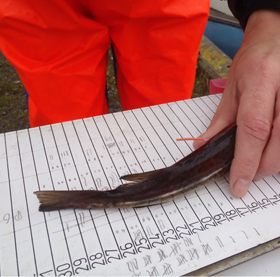Tagging project to map the cods’ growth
Cod is an important species for the Baltic Sea, both as a top predator in the ecosystem and as a source of income for fisheries. Reliable estimates of the variation in population size are necessary in order to manage cod stocks; analyses of the cods’ age is vital. However, researchers have recently found it increasingly difficult to estimate the age of cod in the eastern Baltic, although this is a factor that must be considered when the European Commission decide the annual fishing quotas. To improve knowledge about the eastern Baltic cod's growth a large-scale tagging project is carried out during a four-year period.
Background
Traditionally, age determination of cod is done by examining the otoliths, its “earstones”. The otolith grows at the same rate as the fish, forming annual rings that can be read in much the same way as a tree’s rings. This method’s reliability in cod has long been a subject of discussion, as the growth of cod in the eastern Baltic Sea has slowed, making the age rings unclear and age determination unreliable. The ambiguity of the data has forced the research organisation The International Council for the Exploration of the Sea (ICES), to provide very inexact forecasts for stocks. Since 2013, this data has been so uncertain that ICES has moved to recommending that the European Commission sets fishing quotas for the eastern cod population according to the principle of caution, i.e. not increasing the previous year’s quota, so as to avoid overfishing. However, this principle does not ensure that fishing stays within sustainable limits.
Objective
In the project, called TABACOD (Tagging Baltic Cod), researchers want to determine age and growth in order to be able to make forecasts for population size. Reliable estimations of population sizes will allow ICES to provide member states and the European Commission with advice based on definite data, promoting viable cod stocks in the eastern Baltic Sea.
Method
The researchers will look at a large amount of historical data and combine this with their own surveys. During the project, around 18,000 cod will be caught and marked with traditional external marking and with chemical marking of the otolith. Recapturing externally marked fish is a cost-effective way of measuring the cod’s growth but, depending on the condition of the cod (such as slow growth) on recapture, external markings may not provide adequate data. Chemical marking is an internal lifetime marking in the growing otolith. It allows the researchers to check the otolith’s growth on recapture, and thus the fish’s growth regardless of status (living, dead or frozen). A further 1000 individuals will be marked with DST markings, which register the depths and water temperatures that the cod is exposed to. This makes it possible for the researchers to see the fish’s movement patterns and behaviour in the sea, factors that may affect the cod’s growth. The final phase of the project is to develop and validate a method that can be used to determine the growth over time of cod in the eastern Baltic Sea. The chemistry of the otolith, using historical data, will be the foundation for developing the method, which will then be validated using newly-collected data produced by the project.
BalticSea2020 finances the project, which is conducted under the management of DTU Aqua (Karin Hüssy) and in partnership with the Swedish University of Agricultural Sciences (SLU), the Thünen Institute in Rostock (TI-OSF) and the National Marine Fisheries Research Institute in Gdynia (NMFRI).
For more information, please visit the TABACOD hompage on www.tabacod.dtu.dk
 Photo: Svend-Erik Levinsky
Photo: Svend-Erik Levinsky
Project status
PROJECT MATERIAL
2020-06 - Final report
Tagging Baltic Cod – TABACOD. Eastern Baltic cod: Solving the ageing and stock assessment problems with combined state-of-the-art tagging methods
2016-01-22 - Press release
Major international research project to solve the problem of age determination in cod








